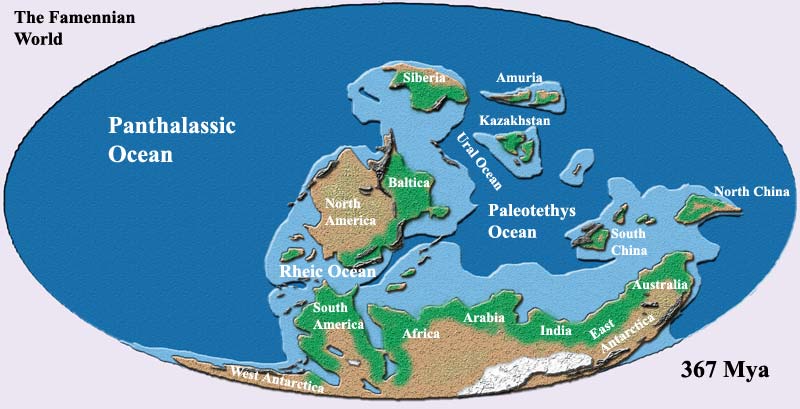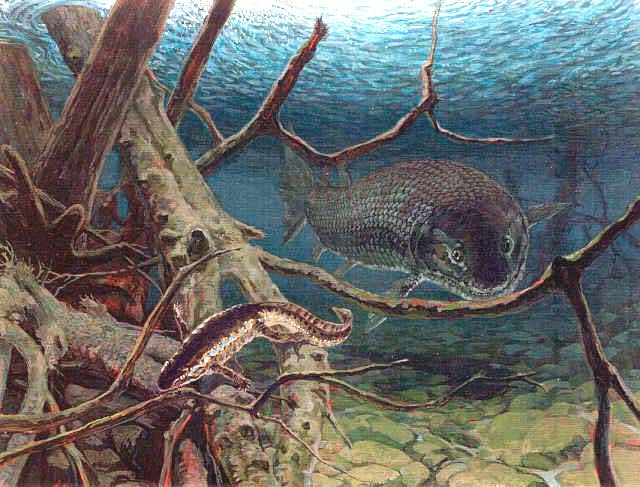
| Late Devonian Epoch | ||
| Paleozoic: Devonian Period |
Famennian Age |
| Frasnian | Middle Devonian | Late Devonian | ||
| Tournasian | Mississippian | Time |

The organisms that survived the Frasnian-Famennian extinction were the ones that were to rule the Earth for the next sixty or so million years. Included were new types of coral, brachiopods, ammonoids, and a number of lineages of fish and tetrapods, as shown in the above illustration.

ATW050114. Map public domain. No rights reserved. An enormous, 2400 x 1200 pixel, unlabelled version of this map is available (free) in all the usual formats, including a Photoshop® *.psd file with each topographical type on a different layer. That one is 9 MB. Email augwhite@sbcglobal.net.
Following the annihilation of the reef organisms with the Frasnian-Famennian mass extinction, only scarce and greatly impoverished reef communities, consisting in the main of algal stromatolites, survived. It was not until well after the beginning of the Carboniferous period, some 10 or 15 million years later, that there was a resurgence in the reef biome.
During the Late Famennian the seed habit evolved. The appearance of gymnosperms occurred when seeds within cup-shaped structures are recorded in an assemblage of 'ferns', lycophytes and progymnosperms in the Famennian deposits from the USA.
With the end of the Frasnian and the advent of Famennian time, brachiopod faunas are known to have undergone mass extinction of many important groups. Two entire orders, the Atrypida and Pentamerida, as well as many Orthid and Stropheodontid families, died out. Of a list of 71 Frasnian genera, only 10 survived into the Famennian. These are Atribonium, Aulacella, Crurithyris, Cupularostrum, Cytina, Cyrtospirifer, Productella, Retichonetes, Schizophora, and Steinhagella. The Early Famennian brachiopod post-extinction assemblage is dominated mainly by only two dwarf species which represent rhynchonellids and spiriferids. There is an intensive process of brachiopod rediversification. and the Frasnian survivors are joined by a new evolutionary radiation, including a great many new rhynchonellid, productid, athyrid, and spiriferid genera, some widely distributed. Thus the Carboniferous fauna actually began during the early Devonian (the productida became so common during the Carboniferous that one could actually call that period the "Age of Productids."

Holoptychius
The characteristic scales of this lobe-finned fish have been found worldwide
length 75 cm
Order Porolepiformes
Devonian Times - a detailed yet very readable account of the important Late Devonian Red Hill fossil locality in Clinton County, north-central Pennsylvania.
page uploaded on Palaeos Site 10 June 2002